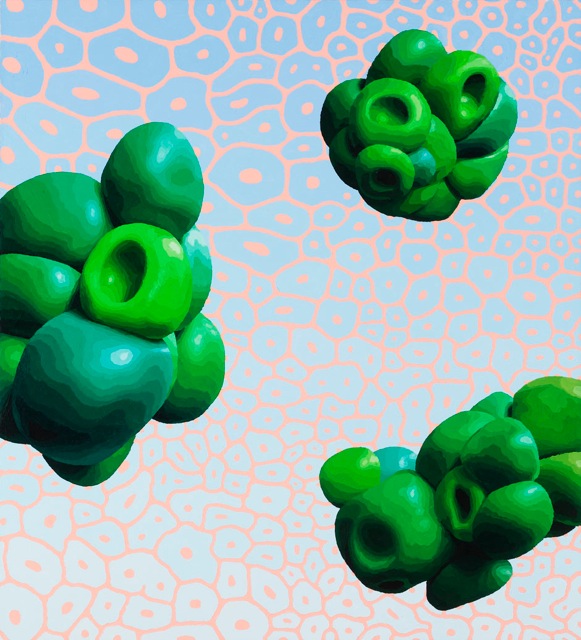
Untitled, 2010. Oil on linen, 44 1/4 x 40 inches (112.4 x 101.6 cm).
This Friday a solo show by artist Alexander "Alex" Ross opens at David Nolan Gallery in New York. Ross is an artist that I feel has been largely overlooked. His paintings and drawings are intriguing oftentimes with a mischievous undertone--images that look as if they could be plucked from a science textbook (cells reproducing under a microscope) but equally elegant and understated, big in color and texture but soft in application. They are representational and at the same time abstract (meets sci-fi), and light-hearted yet equally complex. I sat down with the New York-based artist to talk about his upcoming show and the mad scientist nature of his practice.
Do you approach drawing differently than you do a painting?
They are two very different creatures. The paintings come about methodically by discrete steps: making the clay models, photographing the models, designing and adjusting the photo mock-up, and then finally executing the painting in oil from the mock-up, a phase which is further broken down to many individual color steps! It's like carefully assembling a jigsaw puzzle piece by piece. Drawing is my happy escape valve where I scribble and drip, jumping styles and free-associating without any rules. I am always jumping back and forth between a drawing and a painting.
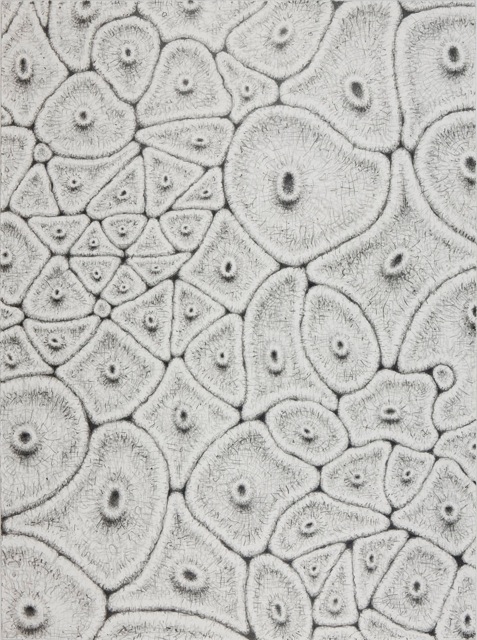
Untitled, 2010. Graphite on paper, 40 x 30 inches (101.6 x 76.2 cm).
Can you tell me about the body of work in this show?
For this show I invented a colorful family of "abstract naturals," forms that are vaguely suggestive of landscape fundamentals such as coral, tree, boulder, mushroom, log, butte, and spire. These I arranged and painted as if they are floating in the air, planted on the ground, or sitting on a table like fruit. So a yellow boulder in the park can also be a hunk of cheese at a smorgasbord. Did I mention this all takes place in another universe?
I really like what you wrote in the catalog statement for this show when talking about painting versus reproductions of paintings in books: "There is only one original and you're either looking at it, or you're looking at a copy of it. The reproduction carries the meaningfulness of the original all over the place, and everywhere it lands it transmits the excitement of its own making along with all the other aesthetic intentions." Can you elaborate briefly on this -- do you think reproductions offer a different experience as seeing a work in person, but an equally valuable one?
Absolutely. Reproductions are the essential social extensions of the original that inform and influence the way we perceive the original over time. But reproductions are also their own thing you can have and hold, like trading cards. Every painting an artist has made over a lifetime can be contained in a single volume for easy assessment and reevaluation. I love the way huge, messy paintings can be flattened and miniaturized for our collective ease and access.
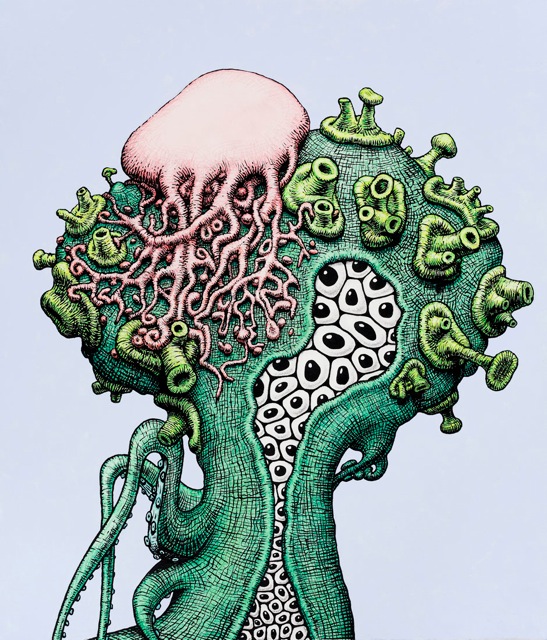
Untitled, 2010. Ink, flashe, graphite and watercolor on paper, 25 3/4 x 22 inches (65.4 x 55.9 cm).
You talk about the "strange spontaneity" and "ever-evolving art biology" that goes into making your art works (in your "art lab"), which I think has always really drawn me to your work. You seem to have many art influences and even say that you don't mind being called "postmodern," and you're having fun making your work. Can you talk more about this?
I set things up for myself in the studio with a few visual ideas and possible directions, and then I shut off my forebrain and just get out of the way. I let things happen as if nature is growing the art through me, using me as a conduit. I also borrow old styles like photorealism and shaped canvases to see if I can't make something new happen by combining them.
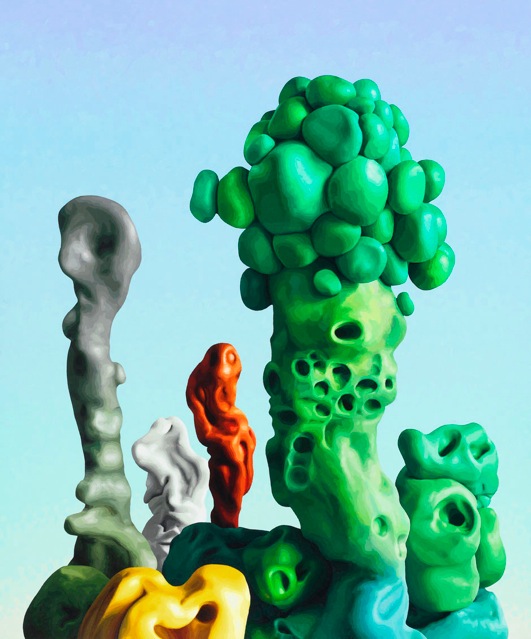
Untitled, 2011. Oil on canvas, 96 x 80 inches (243.8 x 203.2 cm).
Does your work have any direct relationship to science? I ask this because often the creatures or subjects in your work look like some sort of image one might see under a microscope.
Yes yes yes. I love all the new science, you know, carbon nanotubes and pentagonal atomic arrays and lab-grown body parts. It's all so freaky and fascinating. So I'll get that stuff going in the visual mix, like when I drop a cell matrix over a sky or sculpt a row of hexagonal eggs.
Who are some living artists that influence your own work, if there any?
The Italian painter Salvo influenced my painting, Carroll Dunham my drawing, and Dana Schutz and George Condo continue to influence my attitude.
And same question for art history and particular influences?
My three biggest historical influences are Giorgio Morandi, Max Ernst, and those 1970's record sleeves by Roger Dean!
What do you think is the most overlooked thing (for lack of a better word and this 'thing' can be anything, it's wide open) in the art world -- something the art world seems to be missing about contemporary art?
People complain a lot, as if there's something wrong with the art of our time, like maybe we've lost something, because it seems as if art history once had a trajectory and now it's all fragmented. The most overlooked thing is trust! This is the way art unfolds naturally, into a complex, multi-branched forest canopy full of ever evolving avenues.
What do you hope viewers will take with them after seeing this show?
A sense of expanded wonder and a newfound desire to play around.
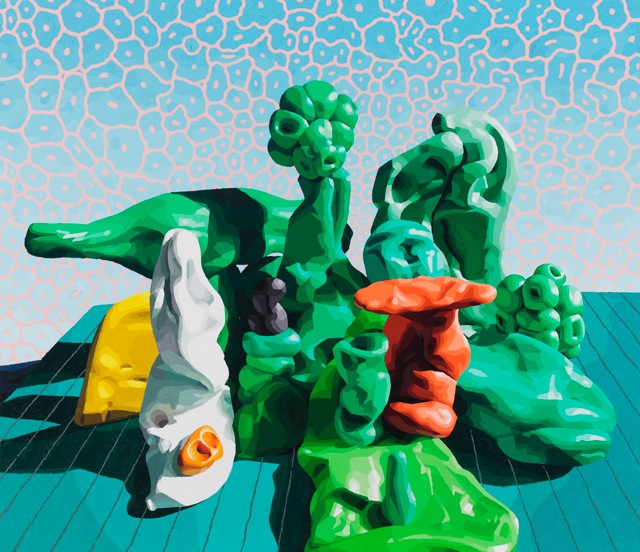
Untitled, 2011. Oil on linen, 52 1/8 x 60 1/8 inches (132.4 x 152.7 cm).
Alexander Ross: Recent Paintings
May 6 - June 18, 2011
David Nolan Gallery, New York
527 West 29th Street